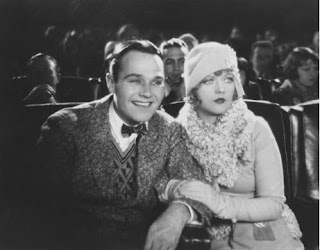a very serious actress
by Douglas Messerli
Agnes Christine Johnston and
Laurence Stallings (screenplay), Ralph Spence (titles), King Vidor (director) Show People / 1928
In the very year when American
silent films had their last gasp, King Vidor and Marian Davies produced one of
the best send-ups of the movie industry, almost cataloging the various silent
screen stars—from Charles Chaplin, William S. Hart, Douglas Fairbanks, Sr.,
Norma Talmadge, and John Gilbert, to Mae Murray, Renee Adoree, Rod LaRoque and
Karl Dane, Leatrice Joy, Claire Windsor, Aileen Pringle, Dorothy Sebastian, and
Polly Moran, all in cameo roles—in the process of spoofing Gloria Swanson’s
career. The two stars of the film, Marion Davies (as Peggy Pepper) and William
Haines (Billy Boone), were themselves Hollywood royalty, and lesser figures
such as Dell Henderson (as Colonel Pepper), Paul Ralli (as Andre), and King
Vidor, playing himself, contributed to the sense that this film was,
unknowingly, a kind “morgue” group photo of the numerous talents whose lives in
just a few years would be ravaged by alcoholism, sexual scandals, suicide, and
just plain forgetfulness of the American audience.
Davies’ forced smile, as she reminds herself of her serious role as an
actress, may have been based on that of Mae Murray, but her toothy performance
of the plot of this slight yet enjoyable comedy is based on Swanson’s life, who
like Peggy began working as a comedic actress before becoming a “true” star,
whose every gesture was calculated to demonstrate the seriousness of her art,
and who would marry into royalty (in Polly’s case, it was to have a phony French
nobleman, Andre, whereas Swanson married Henri, Marquis de la Falaise de la
Coudraye, herself becoming, accordingly, a marquise).
Swanson arose to fame through the Mack Sennett slapstick comedies, while
Peggy Pepper (changed to Peggy Pepoire) in Show People finds fame, with
Billy Boone, in the Comet Comedy company—which Vidor actually filmed on the old
Sennett studios with some of the original Sennett company. As in most Sennett
comedies, Peggy was posed by Vidor to get a pie in the face, but the protests
of Davies’ lover, William Randolph Hearst, left her only with a wet nose of
seltzer.
Kevin Browlow, involved with the restoration of this film (as well as
Abel Gance’s Napolean) reassured the
audience that Swanson never saw this film, but surely she knew about it; Billy
Wilder later invited Haines to play a crony of Nora Desmond in another, much
darker, Hollywood satire, Sunset
Boulevard; noted, by that time, for his interior decoration, Haines turned
the role down. Brownlow noted that of all the people he interviewed, Haines was
the only one who refused to talk about Show
People and other movies of the day.
While there were several successful Davies works before this, including
Vidor’s The Patsy, Davies’ career playing in costume epics such as When
Knighthood Was in Flower had tarnished her screen image, and, just as Peggy
is no longer a screen favorite once she becomes a “serious actress” in the
film, Davies was no longer at her peak—probably the source of the myth, played
out in Citizen Kane, that Hearst’s mistress was untalented. Anyone
seeing Show People, however, will realize how mistaken that notion is,
for Davies as the naïve Georgia belle is a natural comic, wonderful in her
abilities to imitate the pretentions of Hollywood movie stars. That toothy
smile and fluttering eyes are enough to send a large audience (in attendance at
the Academy’s Samuel Goldwyn Theater on Thursday night) into laughter (see the
picture of Mae Murray, whom Davies’ imitates, above).
William Haines, playing, as usual, a likeable, attractive, and masculine
lead, stands his ground, reminding Peggy ultimately, of her roots, and, thus,
saving her from the mistake of marriage to Andre. The fact that Haines was a
relatively open homosexual was unthinkable, surely, to his legions of his women
fans. But only five years later, when Haines arrested for having sex with a
sailor at the Pershing Square YMCA, Louis Mayer gave the actor an ultimatum to
enter into a “lavender” marriage (a fake relationship which helped to hide the
individual’s sexuality from the public) and give up his relationship with his
companion, Jimmie Shields. Haines refused, retiring from the screen despite his
continued popularity. Haines remained with Shields until his death in 1973.
Vidor’s comedy is no masterpiece, but it does amiably take its audience
along for one last slightly hysterical, silent ride through early images of
light and darkness.
Los Angeles, November 3, 2012
Reprinted from International Cinema Review (November 2012).




No comments:
Post a Comment